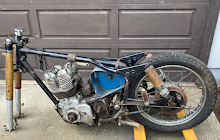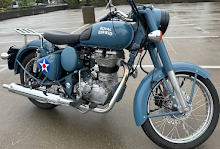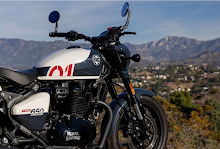David Murray, a stalwart of the Royal Enfield Yahoo Message Board who always signed his posts DWM, moved along to a motorcycle of another brand about a year ago. Quite by accident, I just came across an "open letter" he wrote about his infatuation with his Royal Enfield Bullet. The original story appears on the Chuck Hawks web site that alerted him that such a motorcycle as the Bullet even existed. His story is worth reading. Here is an except:
"Chuck,
"I'm gonna get you for this! Sometime when you least expect it. You just HAD to write that article about the Royal Enfield motorcycle a few years ago, didn't you? (http://www.chuckhawks.com/enfield_bullet.htm)
"I'm sure you meant no harm, but it reached far back into the reptilian brain of an old biker. Caused no end of trouble, I can tell you!
"Dad was a Brit, born and raised within a tram ride of the old Clady circuit in Northern Ireland. He was a seaman, and brought me stacks of motorcycle racing magazines from Britain. The walls of my room were covered with Nortons, Matchless, Velocette, Geoff Duke and Harold Daniell. There was a particular section for the "Norton Girls" as well.
"The 1950's were a different time. Britain was the Saudi Arabia of motorcycles, having at least 50 viable marques at a time when the USA had two. The major racing classes had, for decades, been 350 and 500 cc, and the road bikes in Britain tended to be the same size. A 500 was then a Big Bike!
"There were no motorways in Britain. The usual roads were about as wide as ONE modern interstate lane, were roughly paved, usually wet, torturously twisty, and often had stone walls on both sides. There were damn few places one could go much over 70 and survive, so straight speed was secondary to handling and braking. Brit bikes became known for excellent handling.
"In the USA, the Model T replaced the motorcycle as transportation by about 1915, but higher prices and taxation in Britain rendered the automobile a luxury. A working man rode a motorcycle, right up to the advent of the Mini in the 60s. The British manufacturers were in the business of selling transportation, with ultimate performance a long way second...
"Racing sold bikes, but racing technology didn't percolate down to road bikes, as the buyer didn't want to pay for performance he couldn't use. All the Brit racing bikes had overhead cam motors by the late 20s, but the Triumph Trident and BSA Rocket Three of the 70's were still pushrod motors.
"This was a far cry from today's market, in which bike builders and dealers are primarily selling testosterone. Any Harley or Honda dealer is skilled at implying that, if you don't have a big twin weighing 900 pounds, or a Rice Rocket capable of 160 MPH, well, you might just as well be wearing a gingham pinafore.
"I coveted the big 500 "thumpers", but could never afford one. I did cage a few rides, but I owned Hondas; 90, 250, 400cc bikes. Beautifully engineered, quick, reliable, but somehow soulless. I never named them, and I had about the same level of emotional attachment to them as I do to my Shop-Vac.
"Then I read your damn Article! The Royal Enfield was still in production! New cost, $4,750! That was like a car buff finding that a company in India was still making '57 Chevies, and selling them for $6,000, with a dealer and parts network.
"The bike arrived after dark and I wheeled it into the shop, immediately noticing that the brake lever pulled all the way in to the grip. Spent the next couple hours doing post-dealer-prep-prep, and just admiring the bike. She has a mid-century mechanical look that is music to a gearhead. There's little styling, other than the headlight housing (called the "Casquette"). Form follows function here, and as on a Spitfire or the "Flying Scotsman," the result is beautiful.
"This is NOT a bike for a guy who goes to the dealer to change a lightbulb. You need the factory shop manual, and an aftermarket one written by Pete Snidal. Together, they add up to "adequate." Don't get me wrong, the bike is built like a Bren gun and it isn't going to fall apart, but a buyer who learned about points ignition in History class is going to have to acquire some Paleomechanical skills. We sometimes look back at earlier technology as crude, but just try to design, using the aircraft materials and engines of 1916, a better aircraft than a SPAD.
"The more I went over the bike, the more impressed I became. The Enfield company was always known for innovation. They invented the rubber "cush drive" around 1911, and were the first production bike with swing-arm rear suspension. The factory never supported racing, although many were raced by private entrants, and they were very successful in trials and scrambles.
"I grew up with drum brakes, and they could be pretty bad, but these are double leading shoe drums. That was the pinnacle of drum technology, and very rare on a production bike. Since adjusting them and bedding them in, I'm impressed by their power and modulation. About the rear brake, the less said the better. Fortunately, I don't use it much, anyway. There are no frame tubes under the motor, which is a stressed member. The frame is powder-coated...
"I rolled her out next morning and started up, then sat there laughing my head off. Out of the box, the bike "chuffs." "ChuffChuffChuffChuffChuff!" It's like riding a steam motorcycle! No matter, I had ordered the British made replacement headpipe and short silencer.
"As a portent of things to come, a bunch of kids on skateboards came over to ask what a "Royal Enfield" was. I gave them the story about "The Bike they Forgot to Stop Making," and they pronounced it "Kewell!." DWM
The Vintagent Selects: Bad Dog
-
Alright buddy. Listen up!
The post The Vintagent Selects: Bad Dog first appeared on The Vintagent.
























No comments:
Post a Comment